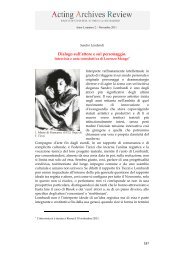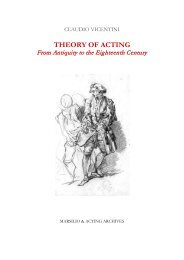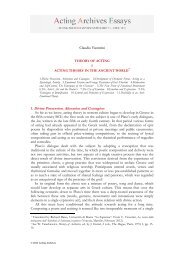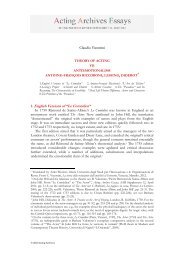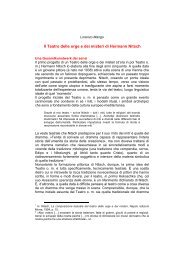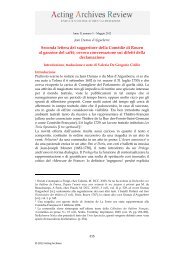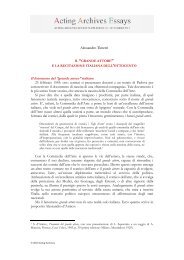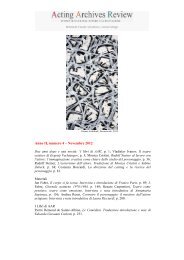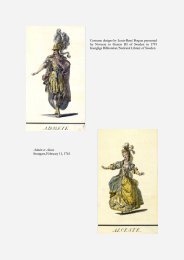Maria Ines Aliverti_The Miniatures of Jean Louis ... - Acting Archives
Maria Ines Aliverti_The Miniatures of Jean Louis ... - Acting Archives
Maria Ines Aliverti_The Miniatures of Jean Louis ... - Acting Archives
Create successful ePaper yourself
Turn your PDF publications into a flip-book with our unique Google optimized e-Paper software.
AAR <strong>Acting</strong> <strong>Archives</strong> Essays Supplement 10 – April 2011<br />
Valentine Green, pub. 19 November 1771 (and re-published by<br />
Boydell in the same year) 93<br />
<strong>The</strong>atrical conversation pieces by other painters to which characters in the<br />
vignettes <strong>of</strong> the first set are related:<br />
• (D.C. no. 34) Nathaniel Dance, David Garrick as King Richard III,<br />
Stratford upon Avon, Town Council, exh. R.A. 1771; various copies<br />
extant; mezzotint engraved by John Dixon, published by Boydell 28<br />
April 1772. <strong>The</strong> costume <strong>of</strong> King Richard in plate 34, is similar with<br />
slight differences<br />
<strong>The</strong> fact that many <strong>of</strong> the vignettes are related to Z<strong>of</strong>fany’s theatrical paintings is<br />
not surprising, for the choice undoubtedly met several needs. At the same time we<br />
can reasonably surmise that the two artists, both native German speakers, had met<br />
through Garrick, whose wife Eva <strong>Maria</strong>, originally a dancer from Vienna,<br />
undoubtedly encouraged the great actor’s patronage <strong>of</strong> artists <strong>of</strong> her native culture<br />
and language. <strong>The</strong> question <strong>of</strong> the dependence <strong>of</strong> these vignettes on Z<strong>of</strong>fany or on<br />
the other theatrical conversation pieces is <strong>of</strong>ten dealt with rather summarily. It is<br />
taken for granted, in fact, that Faesch was not autonomous as a “portraitist” <strong>of</strong><br />
actors, and that he limited himself to adapting works by other artists. Shearer West is<br />
astonished by his ‘originality’ rather than by the contrary, that is by his dependence<br />
on the theatrical conversations pieces.<br />
<strong>The</strong> Sayer’s designer, de Fesch, took certain liberties with his representations. Rather<br />
than delineating a whole scene he broke up the painting into individual engravings. A<br />
work such as Love in a Village appeared not as a scene, but as three separate engravings<br />
<strong>of</strong> Shuter [D.C. no. 11], Beard [D.C. no. 12] and Dunstall [D.C. no. 13] in their<br />
respective characters from the play. Other borrowings from Z<strong>of</strong>fany included the<br />
portrait <strong>of</strong> Powell as Posthumus [D.C. no. 26] and Garrick as Sir John Brute in <strong>The</strong><br />
Provok’d Wife [D.C. no. 9]. Strangely enough, although de Fesch included separate plates<br />
<strong>of</strong> Foote [D.C. no. 19] and Weston [D.C. no. 15] as <strong>The</strong> Devil and Dr. Last, these are<br />
not copies <strong>of</strong> Z<strong>of</strong>fany’s painting [Thomas Weston as Dr. Last and Samuel Foote as <strong>The</strong><br />
Doctor/<strong>The</strong> Devil in <strong>The</strong> Devil upon Two Sticks, 1768-1769, Castle Howard, Simon Howard<br />
Collection] but rather original designs. Why de Fesh copied some Z<strong>of</strong>fany works and<br />
not others is a mystery. 94<br />
For some plates Faesch restricted himself to “copying” accurately the actors in the<br />
poses shown in the theatrical conversation pieces. This is the case <strong>of</strong> the vignettes<br />
drawn after the conversation pieces <strong>of</strong> Wilson (Garrick in King Lear and Garrick in<br />
Hamlet), <strong>of</strong> Pine (Reddish as Posthumus), and <strong>of</strong> several vignettes drawn after Z<strong>of</strong>fany.<br />
However, several theatrical conversations <strong>of</strong> Z<strong>of</strong>fany and that <strong>of</strong> Pine, from which<br />
the vignettes produced in the period 1768-1769 derived, are contemporaneous with<br />
93 Ch. Lennox-Boyd, <strong>The</strong>atre: <strong>The</strong> Age <strong>of</strong> Garrick, pp. 71-73, no. 30.<br />
94 Shearer West, <strong>The</strong> Image <strong>of</strong> the Actor, London, Pinter Publishers, 1991, pp. 46-48. Here West, without<br />
altering it much, reproduces the opinion <strong>of</strong> Raymond Mander and Joe Mitchenson (<strong>The</strong> Artist and the<br />
<strong>The</strong>atre, London, Heinemann, 1955), according to whom Faesch limited himself to drawing the actors<br />
after the theatrical conversation pieces <strong>of</strong> Wilson and Z<strong>of</strong>fany. John P. Cavanagh was, rightly, <strong>of</strong> the<br />
opposite opinion: on this point see Section 7.<br />
38



